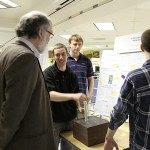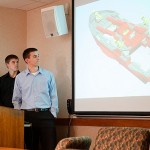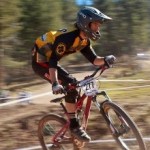 Dr. Jeffrey Allen teaches Advanced Thermodynamics (MEEM 5200) and Principles of Energy Conversion (MEEM 4200/5290). Principles of Energy Conversion introduces the basic background, terminology, and fundamentals of energy conversion. Students develop project posters for current and emerging technologies for production of thermal, mechanical, and electrical energy. Topics include fossil and nuclear fuels, solar energy, wind turbines, fuel and solar cells.
Dr. Jeffrey Allen teaches Advanced Thermodynamics (MEEM 5200) and Principles of Energy Conversion (MEEM 4200/5290). Principles of Energy Conversion introduces the basic background, terminology, and fundamentals of energy conversion. Students develop project posters for current and emerging technologies for production of thermal, mechanical, and electrical energy. Topics include fossil and nuclear fuels, solar energy, wind turbines, fuel and solar cells.
Mechanical Engineering – Engineering Mechanics Graduate Seminar: December 13, 2012; 4:00 – 5:00 p.m., Room 112, ME-EM Building
Christopher S. Johnson, Ph.D., Chemical Sciences and Engineering Division, Argonne National Laboratory
Dr. Christopher S. Johnson is currently a chemist at Argonne National Laboratory, specializing in the research & development of battery materials and battery systems with over 20 years of experience. His education background is the University of North Carolina at Chapel Hill (B.S. Chem.) and Northwestern University earning his Ph.D. in 1992. He has been active in the lithium battery materials field having published over 90 publications and 10 patents issued. He is cathode projects leader at Argonne, and has managed several DOE, AFRL contracts and work-for-others programs. He was elected a Member-at-Large of the Battery Division of The Electrochemical Society (ECS) in 2008, and the Treasurer in 2010. He is active in organizing battery subject symposia at biannual ECS meetings. He is a member of the American Chemical Society, Materials Research Society, the Society for Electroanalytical Chemistry, and The Electrochemical Society-Battery Division since 1993. He has received research awards from the International Battery Association in 2006, and a R&D-100 award for the commercialization of lithium battery materials in 2009. Currently he is developing room-temperature Na-ion batteries for niche applications.
Title: Advanced Materials to Enable High-Energy Li and Na-Ion Batteries
The need for energy storage and its rising demand has become a major issue that the world faces today and going forward in the future. Lithium-ion (Li-ion) batteries are widely used for energy storage in a myriad of portable consumer applications and now are being introduced in transportation technologies, such as plug-in hybrid (PHEV) electric vehicles. The small size and low weight of the batteries have enabled new devices for many applications. The specific energy and power of Li-ion batteries continues to grow as high-performance anode and cathode materials become commercially available. This presentation will focus on advanced materials and their chemistry for Li-ion battery applications and also emerging low-cost Na-ion batteries as energy storage chemistry for electrical grid applications.
by Jenn Donovan, public relations director
Mercury Marine, a longtime corporate partner of Michigan Tech, has donated a laser interferometer to Michigan Tech’s Department of Mechanical Engineering-Engineering Mechanics. The piece of equipment, valued at approximately $125,000 when new, uses a laser to produce digital images of the amount of strain that parts undergo as they are stressed in various ways.
Mechanical Engineering – Engineering Mechanics Graduate Seminar: December 6, 2012; 4:00 – 5:00 p.m., Room 112, ME-EM Building
Professor Cortino Sukotjo, Assistant Professor at Department of Restorative Dentistry, College of Dentistry
University of Illinois at Chicago
Dr. Cortino Sukotjo received his Dental Degree from Padjadjaran University in Indonesia, followed by Ph.D in Oral Biology from College of Dentistry, University of California at Los Angeles. He then pursued his specialty training in Prosthodontics at Harvard School of Dental Medicine. Presently he holds a position as Assistant Professor at Department of Restorative Dentistry, College of Dentistry, University of Illinois at Chicago and adjunct
assistant professor at Michigan Technology University. His research interest is in the area of implant surface modification iand dental education.
Title: Current Research Trend in Implant Dentistry
Dental Implant has been used widely to replace missing teeth. However, the implant success rates in patients with smoking and/or uncontrolled diabetic history are still relatively lower than healthy individuals. To improve implant success rate, implant surface modification is needed. In this presentation, I will present some background about implant dentistry and current research trend in implant dentistry such as implant corrosion and implant surface modification.
 The Fall 2012 Mechanical Engineering – Engineering Mechanics Department PACE competition was held on 14th November 14th.
The Fall 2012 Mechanical Engineering – Engineering Mechanics Department PACE competition was held on 14th November 14th.
The First Place team was Team 8: “Lego Fire Command Craft” with Drew Brennan, Robert Cooper, Michael Ponte and Matthew Verbiscus.
The PACE Design Competition will judge five critical areas of your design project:
1. Form: Design Concept, Creativity, Perceived Value, Safety
2. Fit: Physical Model (realism, aesthetics, detail, supporting design)
3. Function: Design Parameters and Performance (math models, simulations, spreadsheets, etc.)
4. Presentation: Effective, Professional, Credible
5. Teamwork and Collaboration.
PACE – Partners for the Advancement of Collaborative Engineering Education – is a university and industry partnership to support strategically-selected academic institutions worldwide, to develop the automotive product life cycle management team of the future. PACE partners include General Motors (GM), Electronic Data System (EDS), UGS and Sun Microsystems, with contributing companies such as Hewlett Packard, Altair Engineering and MSC Software. PACE has already provided over $10M in CAD/CAM/CAE hardware and software to the ME-EM department.
Mechanical Engineering – Engineering Mechanics Graduate Seminar: November 29, 2012; 4:00 – 5:00 p.m., Room 112, ME-EM Building
Professor Rafael Fierro, Department of Electrical & Computer Engineering, University of New Mexico
Rafael Fierro is an Associate Professor of the Department of Electrical & Computer Engineering, University of New Mexico where he has been since 2007.
He received a M.Sc. degree in control engineering from the University of Bradford, England and a Ph.D. degree in electrical engineering from the University of Texas-Arlington. Prior to joining UNM, he held a postdoctoral appointment with the GRASP Lab at the University of Pennsylvania (1999- 2001) and a faculty position with the Department of Electrical and Computer Engineering at Oklahoma State University (2001-2007). His research interests include nonlinear and adaptive control, robotics, hybrid systems, autonomous vehicles, and multi-agent systems. He directs the Multi-Agent, Robotics, Hybrid and Embedded Systems (MARHES) Laboratory. Rafael Fierro was the recipient of a Fulbright Scholarship, a 2004 National Science Foundation
CAREER Award, and the 2007 International Society of Automation (ISA) Transactions Best Paper Award. He is serving as Associate Editor for the IEEE Control Systems Magazine and IEEE Transactions on Automation Science and Engineering.
Title: Coordination Strategies for Robotic Networks
Advances in embedded processor and sensor technology in the last thirty years have helped accelerate interest in the field of robotics. As robots become smaller, more capable, and less expensive, there is a growing demand for teams of robots in various application domains. Robotic networks are particularly well suited to execute tasks that cover wide geographic ranges, require significant parallelization, and/or depend on capabilities that are varied in both quantity and difficulty. Example applications include littoral exploration and surveillance, rainforest health monitoring, autonomous transportation systems, warehouse automation, and hazardous waste clean-up. This talk focuses on synchronization strategies to control robotic networks. I will first discuss an adaptive binary consensus approach to decentralized coordination of nonholonomic sensor networks. I will then show that this binary consensus protocol not only improves the performance of the adaptive law but allows the compression of the date shared among the mobile sensors. Finally, I will describe our recent work on the problem of detecting changes in the topology of a robotic network through synchronization of chaotic oscillators.
Mechanical Engineering – Engineering Mechanics Graduate Seminar: November 15, 2012; 4:00 – 5:00 p.m., Room 112, ME-EM Building
Professor Ezra Bar-Ziv, Mechanical Engineering – Engineering Mechanics, Michigan Technological University
Dr. Bar-Ziv obtained his B.Sc. degree in Physics and Chemistry from the Hebrew University, then joined Nuclear Research Center (NRCN), Israel, during which he received his Ph.D. from the Weizmann Institute of Science in 1975. At NRCN he managed large projects on energy and materials, including substantial industrial work on coal combustion. Dr. Bar-Ziv moved to Ben-Gurion University (BGU) on 1998 as a Professor and founded the Laboratory for Clean Combustion, where he carried out extensive industrial research on coal combustion and thermal processes of various wastes. Dr. Bar-Ziv founded E.B. Clean Energy for the development of biomass and MSW torrefaction technology for the power industry.
On 2011 he moved as a Professor to Michigan Tech to establish a program on biomass torrefaction and its applications to the power industry. Dr. Bar-Ziv is areas of research are: combustion and gasification of coal; biomass torrefaction; combustion and pyrolysis of thermoplastics; and clean coal combustion in utility boilers.
Title: “Biocoal: A Drop-In Fuel in Coal-fired Power Plants”
Biomass torrefaction to produce biocoal gained interest as it solves hindrances encountered when using raw biomass for power generation. Biocoal is a premium drop-in fuel in pulverized-coal boilers aimed at the reduction of greenhouse gas and other emissions. Biomass torrefaction produces a material with properties similar to coal. Because these properties can be controlled and reproduced, biocoal can be utilized as a “drop-in” fuel replacement for coal. Coal’s efficiencies and energy generation capabilities are well documented as well as its high level of greenhouse gas and other emissions. Biocoal offers many of the benefits of coal and also: (1) significant reduction of emissions (NOx, SOx, particles, mercury, CO2), (2) uses low-cost equipment, and (3) a low-cost source of renewable energy. We will present an integrated-synergistic approach that will: (1) produce the most suitable biocoal for the specific boiler; and (2) carry out comprehensive analysis and evaluation of the performance of the entire coal-fired power plants, including the combustion chamber, the steam generation elements, auxiliary and supporting equipment, and emissions. The selection of the suitable biocoal properties and the reliable analysis of the power plant performance prior to firing will reduce significantly the risks involved in fuel change in the power plant by using biocoal.
Mechanical Engineering – Engineering Mechanics Graduate Seminar: November 8, 2012; 4:00 – 5:00 p.m., Room 112, ME-EM Building
Dr. Chong-Min Wang, Environmental Molecular Sciences Laboratory,
Pacific Northwest National Laboratory
Dr. Chongmin Wang is a senior scientist at Environmental Molecular Sciences Laboratory (EMSL) of Pacific Northwest National Laboratory (PNNL). He received his undergraduate education in physics and a Master degree in solid state science both from Lanzhou University in China. He received his Ph.D in Materials Science and Engineering from University of Leeds, United Kingdom in 1994. He worked at the Max-Planck-Institute for Metal Research in Stuttgart, Germany from 1994 to 1996 as an Alexander von Humboldt Research Fellow. In 1996/97, Dr. Wang worked as a research scientist at the National Institute for Research in Inorganic Materials. He was a research scientist in the Materials Research Center at Lehigh University from 1997 to 2001.
Dr. Wang joined PNNL in June 2001. He leads the EMSL’s transmission electron microscopy (TEM) facilities. Dr. Wang has expertise on the atomic level characterization/visualization of materials structure and their physical and chemical behavior. He works on correlating materials structural and functional properties with atomic and electronic structure and chemical compositions, particularly nanomaterials related to energy conversion, storage, and sustainability. Currently, Dr. Wang’s focus is on developing methods that enable in-situ atomic level observation of electrochemical process (energy conversion and storage such as lithium ion battery), and mechanical behavior (such as stress-strain, impurity/dopant segregation, grainboundary or interface mediated mass transport, and defect clustering, radiation damage) using aberration corrected HRTEM and HR-STEM. These aspects of his research provide insight for correlating properties and structure at nanometer scale under dynamic operating conditions.
He is the recipient of the Rowland Snow Award from the American Ceramic Society, the Outstanding Invention Award from the Japanese Science and Education Committee, and a R&D100 award.
Dr. Wang pioneered the concept of a nanobattery using ionic liquid and a single nanowire for insitu TEM studies. This research led to the receipt of the 2012 Microscopy Today Innovation Award of Microscopy Society of American.
Title: Nanoscale designing towards high capacity, high power rate, long cycle life, and safe operation for lithium ion battery
We use lithium ion batteries daily as they power our everyday electronics such as cell phones, laptops, cameras, tools, and electrical cars, and potentially stationary storage. However, there are fundamental challenges that need to be addressed for these applications, such as capacity, power rate, cycle life, and safe operation. A range of materials has a high theoretical capacity, but in reality, this type of material cannot be used directly due to a fast capacity fade. It is believed that the capacity fading and short cycle life of the battery using this type of materials are directly related to the overall large volume expansion and anisotropic accommodation of the volume change. I will discuss the fundamental challenges and possible ways to counter act them. In particular, I will review some of the general nanoscale designing concepts for tailoring composite materials based on silicon and carbon as anode materials for high capacity and long cycle life. For the cathode materials, doping of
transition metals has proved to be a viable way for high voltage and high capacity. However, the spatial distribution of the dopant ions appears to play a key role on the performance of the cathode materials. I will also
present recent progress on the development of in-situ TEM capabilities for probing the structural evolution of both anode and cathode materials for lithium ion battery.
Michigan Technological University won two more national championships and they didn’t happen on the ice or in the classroom. Paul Mayes won the dual slalom and downhill events at the 2012 USA Cycling Collegiate Mountain Bike Championships, held Oct. 20-21 in Angel Fire, N.M.
Mechanical Engineering – Engineering Mechanics Graduate Seminar: November 1, 2012; 4:00 – 5:00 p.m., Room 112, ME-EM Building
Dr. Robert F. Klie, University of Illinois at Chicago
Dr. Robert F. Klie is a widely recognized expert in Z-contrast imaging, electron energy-loss spectroscopy (EELS) and in-situ experiments. Dr. Klie is an Associate Professor in the Physics Department at the University of Illinois at Chicago, where he has pioneered the in-situ heating and cooling experiments using atomic Z-contrast imaging and EELS of oxide grain boundaries, heterogeneous catalysts, as well as semiconductor thin-films.
Dr. Klie has authored over 80 papers in peer-reviewed journals, which have been cited over 1400 times since 1998, and has an h-index of 20. As a scientist, Dr. Klie has over 10 years of experience in academic and industrial research, including his current appointment at UIC and previously Brookhaven
National Laboratory. Recently, Dr. Klie was the PI on a grant to purchase an aberration-corrected scanning transmission electron microscope (STEM), which has been installed at UIC last year. Currently, the JEOL JEMARM200CF is the highest resolution 200 kV STEM in the United States which allows for in-situ experiments, and provides 68 pm spatial, as well as 0.35 eV energy resolution.
Title: Chemical analysis with sub-Å resolution: T he power and challenges of aberration-corrected scanning transmission electron microscopy
The last few years have seen a paradigm change in (scanning) transmission electron microscopy, (S)TEM, with unprecedented improvements in both spatial and spectroscopic resolution being realized by aberration
correctors, cold-field emission guns and monochromators. The spatial resolution now extends to the subangstrom
level, while the spectroscopic resolution has reached the sub-100 meV regime. In-situ stages
have further extended the temperature range where atomic-resolution can be achieved between 10 K and
1,000 K. These instrumentation developments have brought notable successes in materials analysis, in
particular for interfacial, catalysis and thin-film studies. However, they have also challenged the established
experimental protocols and our fundamental understanding of both imaging and spectroscopy in the STEM.
In this presentation, examples of where the new instrumentation has been successfully used to address materials physics issues in nanoscale systems will be described, including magnetic transitions in oxide thin films, pn-junctions in semiconductor nanowires, and promoter diffusion in heterogeneous nanocatalysts.
Furthermore, the challenges associated with operating these new STEMs for reliable quantitative imaging and spectroscopy will be discussed. Finally, I will present a perspective on the future developments in STEM analysis.
PDF Flyer
